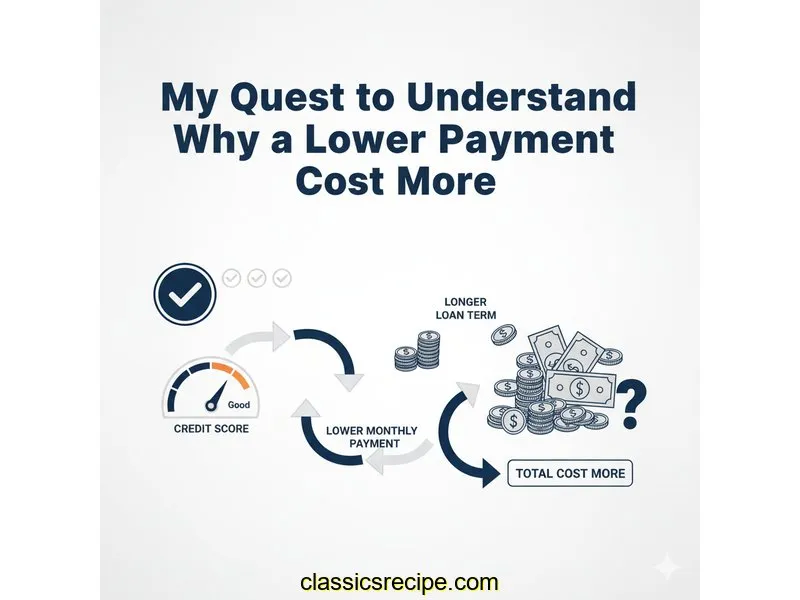
Auto Loan Calculator
Calculate payments over the life of your Loan
Home Blog Privacy Terms About Contact
Calculate payments over the life of your Loan
Home Blog Privacy Terms About ContactPublished on October 14, 2025

It all started with a simple chat over coffee. My friend was telling me about a personal loan they got for some home updates. I was thinking about something similar, so my ears perked up. They mentioned their loan was for about $13,850, and they were really happy because their monthly payment was only around $233. My first thought was, "Wow, that's incredibly low!" It sounded so much more manageable than what I was expecting.
That single number—$233—stuck in my head. When I got home, I pulled up an online loan calculator, eager to see how it all worked. I punched in the same loan amount, but I didn't know their exact interest rate or term, so I started playing with the numbers. No matter what I did, I couldn't seem to get a payment that low unless I stretched the loan term way, way out. That's when the real question hit me: how does stretching out the time change the numbers so drastically? And more importantly, what am I not seeing?
This wasn't about making a financial decision; it was about a puzzle I suddenly needed to solve. Why did one variable, the loan term, have such a powerful effect on the monthly payment? Was a lower payment always the better outcome? I realized I didn't actually understand the mechanics behind the curtain. My goal became simple: to truly grasp the relationship between the loan term, the monthly payment, and the total amount of money I'd actually pay back. This is my journey of figuring that out. It’s about understanding how calculations work, not about financial advice.
I decided to dedicate some time to this, treating it like a personal project. I wanted to move from just plugging numbers into a calculator to actually understanding what the calculator was doing. It was a quest for calculation literacy, driven by the simple mystery of that surprisingly low monthly payment.
Armed with my newfound curiosity, I dove back into the online calculators. I decided to create a clear, side-by-side comparison to solve the puzzle my friend's loan had presented. I used their numbers as a baseline: a $13,850 loan amount. I found a representative interest rate, let's say 6.8%, to use for both scenarios to keep things consistent.
First, I replicated my friend's situation. I entered $13,850 for the loan amount, 6.8% for the interest rate, and a 72-month (6-year) term. The calculator spit out a monthly payment of $233.15. There it was. That manageable, low number. My initial reaction was validation: "Okay, a low payment is possible." My brain immediately labeled this as the "good" option.
Next, I created my own scenario. I kept the loan amount and interest rate exactly the same but shortened the term significantly to 48 months (4 years). The calculator returned a new monthly payment: $328.69. This was nearly $100 more per month! My immediate, gut reaction was one of aversion. "That's way higher," I thought. "Why would anyone choose that?" I was stuck in a mental trap, focusing entirely on that single output field: the monthly payment.
This is where my real confusion began. I was comparing $233.15 to $328.69 and drawing a simple, but completely wrong, conclusion. For a moment, I just stared at the screen, thinking I must be missing something obvious. My mistake was that I wasn't thinking about the *total*. I was only considering the short-term impact on a monthly budget. In my mind, the loan that "cost" $233 a month was clearly cheaper than the one that "cost" $328 a month. It was an incomplete and misleading picture, and my frustration grew because the math felt both simple and impossibly complex at the same time.
I almost gave up. I figured maybe finance was just one of those things I’d never fully get. But as I was about to close the browser tab, my eyes drifted over to a different section of the calculator results, a section I had completely ignored: "Total Interest Paid." It was right there next to the monthly payment, but my brain had filtered it out. Suddenly, I had a new clue.
I decided to run my two scenarios again, but this time, I would focus exclusively on this new piece of information. The results were startling and changed my entire perspective. The "cheaper" 72-month loan that cost $233.15 per month came with a total interest cost of $2,936.80. The "more expensive" 48-month loan at $328.69 per month had a total interest cost of only $1,927.12. That was a difference of over $1,000! The lower payment actually cost more. It was a classic "aha!" moment where a complex idea suddenly becomes crystal clear.
My first big lesson was that the loan term isn't just a measure of time; it's a key ingredient in the interest calculation. A longer term, like 72 months, means you're making smaller payments. But because the principal balance decreases more slowly, you end up paying interest for a longer period on a larger average balance. Each of those 72 payments includes an interest charge.
The higher monthly payment of the 48-month loan ($328.69) was actually a good thing from a total cost perspective. A larger portion of each payment was going toward reducing the principal amount owed, rather than just servicing the interest. Because the principal was being paid down faster, there was less time for interest to accumulate. It was a trade-off: higher monthly payments in exchange for a lower overall cost.
The final piece of the puzzle fell into place when I clicked the "Show Amortization Schedule" button. For the 72-month loan, I could see that in the first year, a huge chunk of each $233 payment went straight to interest. For the 48-month loan, a greater percentage of each $328 payment was attacking the principal from day one. Seeing the numbers broken down month-by-month made the concept tangible. It wasn't abstract math anymore; it was a clear, visual story of where the money was going.
To make sure I really understood, I ran a completely different scenario: a $18,200 loan at 7.2%. I compared a 36-month term to a 60-month term. The pattern was exactly the same. The 60-month loan had a much lower monthly payment but cost significantly more in total interest. My discovery was confirmed. I finally had the confidence that I understood the mechanics.
This whole journey of exploration taught me so much more than just the answer to my initial question. It gave me a new level of literacy in how loan calculations actually work. It’s empowering to look at a calculator and understand the story the numbers are telling. Here are the key lessons I took away about the calculations themselves:

As I went through this process, I kept asking myself questions. Here are some of the key ones I found answers to, which might be helpful for anyone else on a similar learning journey.
The loan term directly determines how many payments you have to spread the principal and total interest over. A longer term (e.g., 72 months) gives you more payments, so each individual payment can be smaller. A shorter term (e.g., 48 months) requires you to pay back the loan faster, so each payment must be larger.
Interest is calculated based on the outstanding principal balance. With a longer-term loan, your principal balance decreases more slowly. This means you are borrowing the money for a longer period, and interest accrues for every single one of those extra months. Even though the monthly payment is lower, the cumulative interest charges add up to a much larger amount over the full life of the loan.
From a purely mathematical standpoint of understanding the cost of borrowing, the "total interest paid" is one of the most revealing numbers. It shows the exact amount you are paying the lender on top of the money you borrowed. While the monthly payment is critical for budgeting, the total interest reveals the overall financial impact.
The best way is to run side-by-side comparisons. Keep the loan amount and interest rate the same, but change the loan term. For example, enter a 36-month term and note the monthly payment and total interest. Then, change only the term to 60 months and compare the new results. This isolates the effect of the term and makes the trade-off very clear.
My exploration, which started with a simple question about a friend's loan payment, ended up being an incredibly valuable lesson in financial literacy. The biggest takeaway for me was realizing that the most attractive number at first glance—the low monthly payment—isn't always the full story. It’s just one piece of a much larger puzzle. Learning to look past it to fields like "total interest paid" and to understand the story told by an amortization schedule felt like learning a new language.
I feel much more confident now, not in making financial choices, but in my ability to understand the math that underpins them. It’s a reminder that taking the time to play with the numbers, ask questions, and explore how these calculations work is a powerful tool for anyone. It's not about finding the "right" answer, but about understanding what the different answers truly mean.
This article is about understanding calculations and using tools. For financial decisions, always consult a qualified financial professional.
Disclaimer: This article documents my personal journey learning about loan calculations and how to use financial calculators. This is educational content about understanding math and using tools—not financial advice. Actual loan terms, rates, and costs vary based on individual circumstances, creditworthiness, and lender policies. Calculator results are estimates for educational purposes. Always verify calculations with your lender and consult a qualified financial advisor before making any financial decisions.
